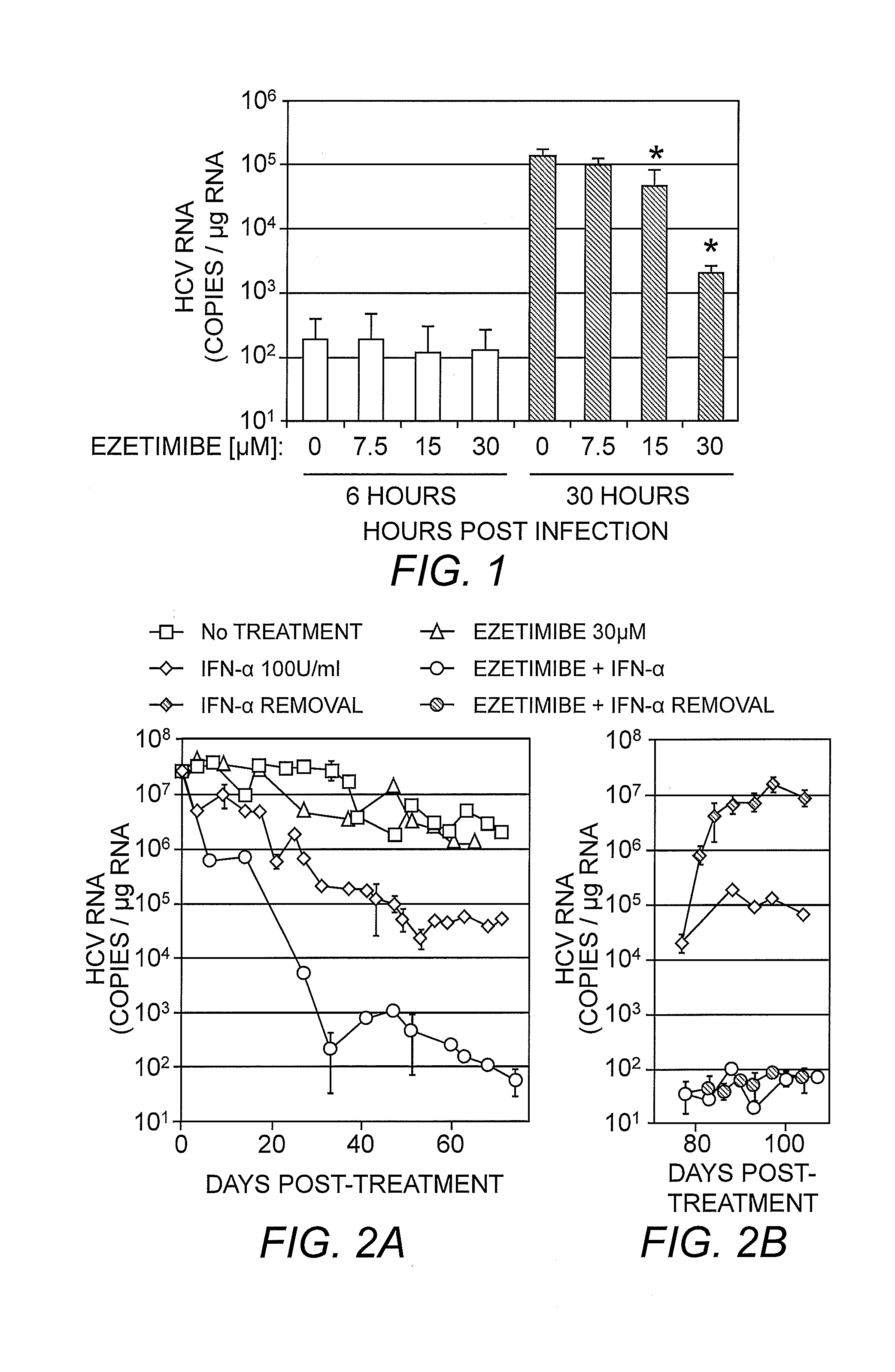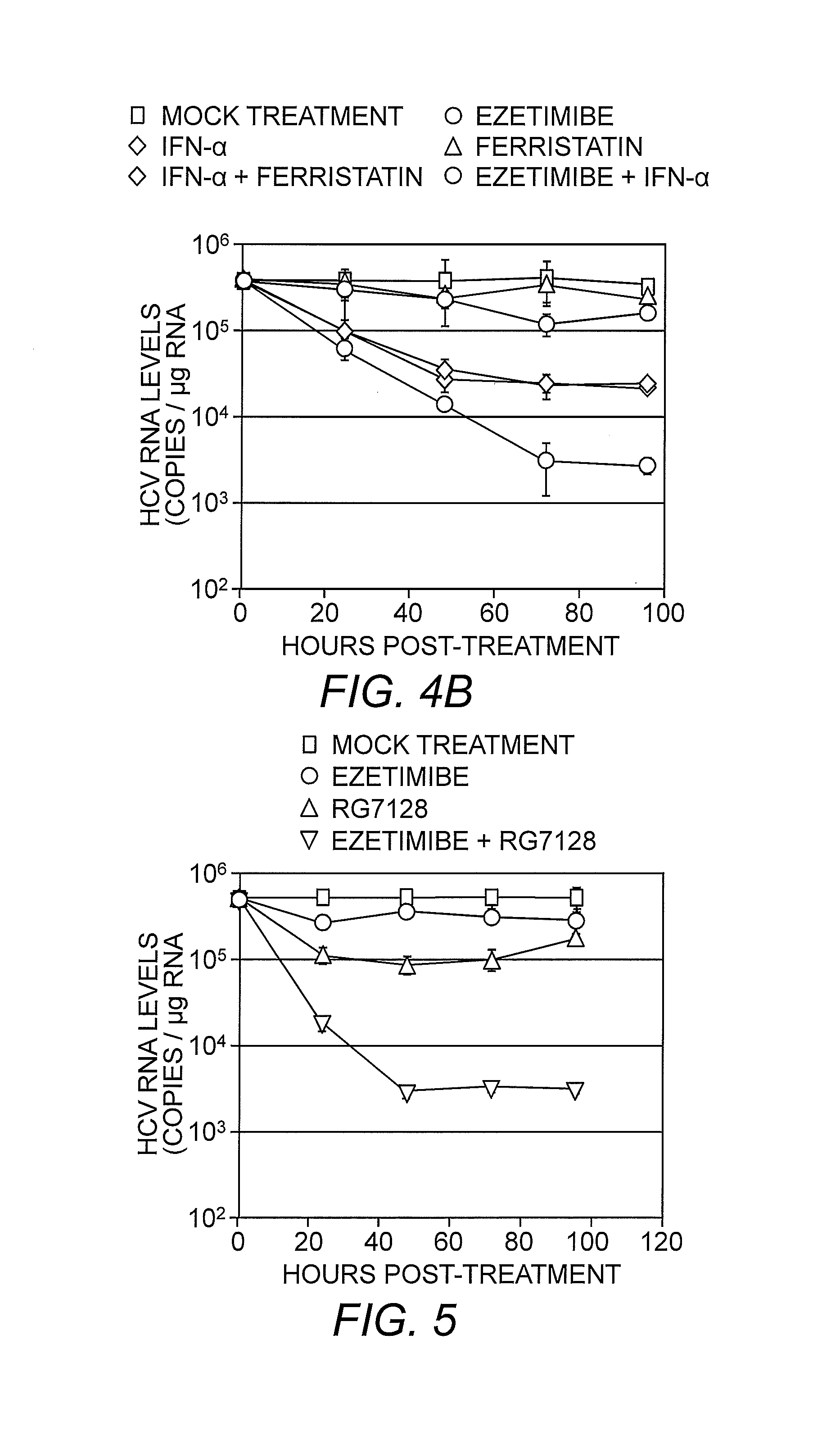Compositions and methods for inhibiting entry of a hepatic virus
a technology of hepatic virus and composition, which is applied in the direction of biocide, drug composition, peptide/protein ingredients, etc., can solve the problems of inability to effectively inhibit the entry of hcv, and inability to prevent infection by vaccine, so as to reduce or and prevent the entry of hcv.
- Summary
- Abstract
- Description
- Claims
- Application Information
AI Technical Summary
Benefits of technology
Problems solved by technology
Method used
Image
Examples
example 1
Methods
[0041]Cells.
[0042]Huh7 cells, also known as Huh7 / scr cells, are well-known in the art (Zhong, et al. (2005) Proc. Natl. Acad. Sci. USA 102, 9294-99; Gastaminza, et al. (2006) J. Virol. 80:11074-81; Zhong, et al. (2006) J. Virol. 80:11082-93; Sainz et al. (2009) PLoS ONE 4:e6561). The Clone B HCV genotype 1b sub-genomic replicon (sg1b) Huh7 cells were obtained through the NIH AIDS Research and Reference Reagent Program and have been previously described (Blight, et al. (2000) Science 290:1972-1974). The HCV sg2a replicon was established as previously described (Uprichard, et al. (2006) Virol. J. 3:89). Briefly the HCV genotype 2a subgenomic replicon RNA (psgJFH1; Kato, et al. (2003) Gastroenterology 125:1808-17) was XbaI linearized, in vitro transcribed using MEGASCRIPT T7 (Ambion, Austin, Tex.) and transfected into cells using a modified electroporation protocol (Krieger, et al. (2001) J. Virol. 75(10):4614-24). All cells were cultured in complete Dulbecco's modified Eagle's ...
example 2
Ezetimibe Blocks Entry of HCV Into Cells
[0063]Ezetimibe, a 2-azetidinone class of drug, is an anti-hyperlipidemic, cholesterol-lowering medication which has been shown to inhibit cholesterol absorption in vivo, lowering plasma LDL and total cholesterol in treated individuals (Gupta & Ito (2002) Heart Dis. 4:399-409; Bays, et al. (2008) Expert Rev. Cardiovasc. Ther. 6:447-70). Since infectious HCV particles are enriched in cellular cholesterol (Aizaki, et al. (2008) J. Virol. 82:5715-24), it was contemplated that ezetimibe might also inhibit HCV entry into cells. As such, the ability of ezetimibe to inhibit HCV entry was evaluated by performing a HCV foci reduction assay. Huh7 cells were inoculated with cell culture-produced HCV (HCVcc) at a multiplicity of infection (MOI) of 1.0 or 0.1 focus forming units (FFU) / cell and treated with increasing concentrations (0, 3.125, 6.25, 12.5 and 25μM) of ezetimibe pre-, co- or post-infection. Ezetimibe reduced HCV foci formation in a dose-depen...
example 3
Role of NPC1L1 in HCV Entry
[0072]Studies have shown that a G451R mutation in the viral envelope glycoprotein (E2) results in HCV virions of higher density and faster infection kinetics (thong, et al. (2006) J. Virol. 80:11082-11093). In addition it has been determined that this mutant displays a reduced dependence on SR-B1 for cellular entry (Grove, et al. (2008) J. Virol. 82:12020-12029). Thus, if ezetimibe was blocking HCV entry via an SR-B1 mediated mechanism, it would be expected that the mutant G451R virus would be less susceptible to the effects of ezetimibe. As a result, experiments were performed to assess the antiviral efficacy of ezetimibe against the SR-B1-independent HCVccG451R virus. Monolayers of Huh7 cells were inoculated with either wild-type HCVccJFH-1 or HCVccG451R at an MOI of 0.01 FFU / cell for 12 hours. Ezetimibe treatment at concentrations of 15 or 30 μM was initiated (and then continued) either 6 hours prior to infection, during the 12 hour incubation of the vi...
PUM
| Property | Measurement | Unit |
|---|---|---|
| pH | aaaaa | aaaaa |
| concentrations | aaaaa | aaaaa |
| insulin-resistance | aaaaa | aaaaa |
Abstract
Description
Claims
Application Information
 Login to View More
Login to View More - R&D
- Intellectual Property
- Life Sciences
- Materials
- Tech Scout
- Unparalleled Data Quality
- Higher Quality Content
- 60% Fewer Hallucinations
Browse by: Latest US Patents, China's latest patents, Technical Efficacy Thesaurus, Application Domain, Technology Topic, Popular Technical Reports.
© 2025 PatSnap. All rights reserved.Legal|Privacy policy|Modern Slavery Act Transparency Statement|Sitemap|About US| Contact US: help@patsnap.com



